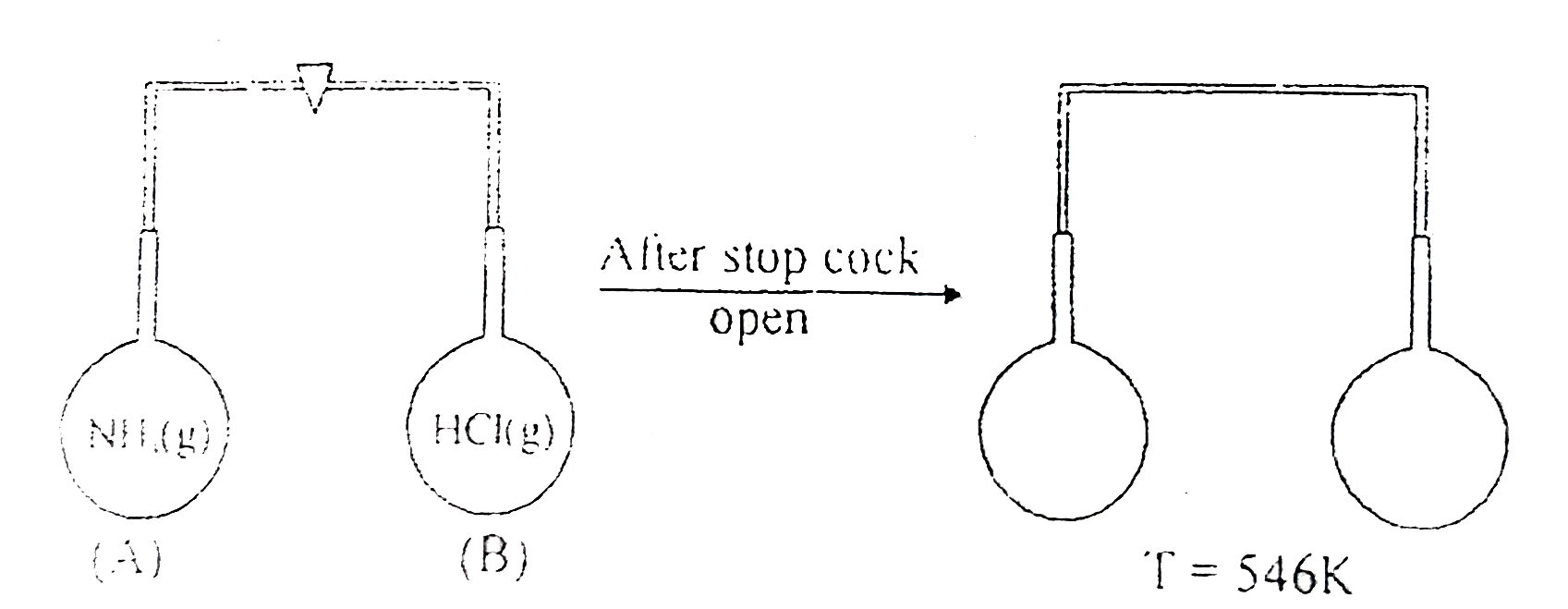Predict ΔS for the reaction :
NH3(g)+HCI(g)→NH4CI(s).
To predict the change in entropy (ΔS) for the reaction:
NH3(g)+HCl(g)→NH4Cl(s)
we can analyze the states of the reactants and products.
1. Identify the States of Reactants and Products:
- The reactants are ammonia (NH₃) and hydrogen chloride (HCl), both in the gaseous state (g).
- The product is ammonium chloride (NH₄Cl), which is in the solid state (s).
2. Understand Entropy (ΔS):
- Entropy is a measure of the disorder or randomness of a system. Higher entropy indicates greater disorder, while lower entropy indicates more order.
- The general order of entropy for states of matter is: gases > liquids > solids. This means gases have the highest entropy, followed by liquids, and then solids.
3. Analyze the Reaction:
- In this reaction, we are converting 2 moles of gaseous reactants (NH₃ and HCl) into 1 mole of solid product (NH₄Cl).
- Since we are going from a gaseous state (higher entropy) to a solid state (lower entropy), we can conclude that the randomness of the system is decreasing.
4. Count the Number of Moles:
- We started with 2 moles of gas and ended with 1 mole of solid. The decrease in the number of moles also contributes to a decrease in entropy.
5. Conclusion:
- Since the reaction involves a transition from a gaseous state to a solid state and a decrease in the number of moles, we can predict that the change in entropy (ΔS) for this reaction is negative.
Thus, we conclude:
ΔS<0
- The reactants are ammonia (NH₃) and hydrogen chloride (HCl), both in the gaseous state (g).
- The product is ammonium chloride (NH₄Cl), which is in the solid state (s).
- Entropy is a measure of the disorder or randomness of a system. Higher entropy indicates greater disorder, while lower entropy indicates more order.
- The general order of entropy for states of matter is: gases > liquids > solids. This means gases have the highest entropy, followed by liquids, and then solids.
- In this reaction, we are converting 2 moles of gaseous reactants (NH₃ and HCl) into 1 mole of solid product (NH₄Cl).
- Since we are going from a gaseous state (higher entropy) to a solid state (lower entropy), we can conclude that the randomness of the system is decreasing.
- We started with 2 moles of gas and ended with 1 mole of solid. The decrease in the number of moles also contributes to a decrease in entropy.
- Since the reaction involves a transition from a gaseous state to a solid state and a decrease in the number of moles, we can predict that the change in entropy (ΔS) for this reaction is negative.
Topper's Solved these Questions
- BOOK - MODERN PUBLICATIONCHAPTER - THERMODYNAMICSEXERCISE - Revision Exercise (Short Answer Questions ) (Fill in the blanks : )5videos
THERMODYNAMICS
- BOOK - MODERN PUBLICATIONCHAPTER - THERMODYNAMICSEXERCISE - Revision Exercise (Short Answer Questions)62videos
THERMODYNAMICS
- BOOK - MODERN PUBLICATIONCHAPTER - THERMODYNAMICSEXERCISE - Revision Exercise (Assertion Reason Questions)15videos
THERMODYNAMICS
- BOOK - MODERN PUBLICATIONCHAPTER - STRUCTURE OF ATOMEXERCISE - Unit Practice Test13videos
STRUCTURE OF ATOM
Similar Questions
Knowledge Check
- Question 1 - Select One
If ΔfG∘ for NH3(g) is −16.4kJmol−1, thenΔG∘ for the reaction: N2(g)+3H2(g)→2NH3(g) is
A32.8kJmol1B16.4kJmol−1C−16.4kJmol−1D−32.8kJmol−1 - Question 2 - Select One
Find the heat change in the reaction:
NH3(g)+HCI(g)→NH4CI(s)
from the following data
NH3(g)+aq→NH3(aq)△H=−8.4KCal
HCl(g)+aq→HCl(aq)△H=−17.3KCal
NH3(aq)+HCl(aq)→NH4Cl(aq)△H=−12.5KCal
NH4Cl(s)+aq→NH4Cl(aq)△H=+3.9KcalA−42.1B−34.3C+34.3D42.1 - Question 3 - Select One
Find the heat change in the reaction : NH3(g)+HCl(g)→NH4Cl(s) from the following data
NH3(g)+aq→NH3(aq),ΔH=−8.4K. Cal.HCl(g)+aq→HCl(aq),ΔH=−17.3K. Cal.NH3(aq)+HCl(aq)→NH4Cl(aq),ΔH=−12.5K. Cals.NH4Cl(s)+aq→NH4Cl(aq),ΔH=+3.9K.Cal.A−42.1B−34.3C+34.3D+42.1
Classify each of the following reactions as combination, decomposition, displacement or double displacement reactions :
NH3(g)+HCl(g)→NH4Cl(s)View SolutionWhich of the following statements is (are) correct about the reaction given below ?
NH4OH+HCI→NH4CI+H2OView SolutionAn experiment is done as shown in diagram then final pressure after stop cock is opened.
[Assume reaction : NH3(g)+HCl(g)→NH4Cl(s) ]
 View Solution
View SolutionWe know that the relationship between Kc and Kp is
Kp=Kc(RT)Δng
What would be the value of Δng for the reaction
NH4CI(s)⇔NH3(g)+HCI(g)View SolutionA 5.00L evacuated cylinder is charged with 25.5g of NH3 and 36.4 g of HCl. Calculate the final pressure at 85.0∘C after the two compounds have reacted completely:
NH3(g)+HCl(g)→NH4CI(s)View Solution

